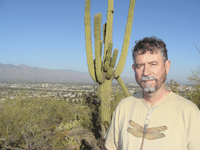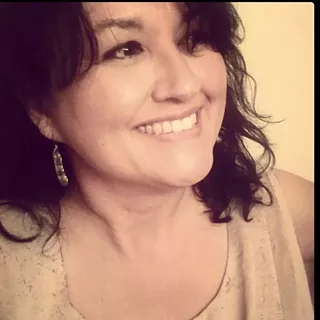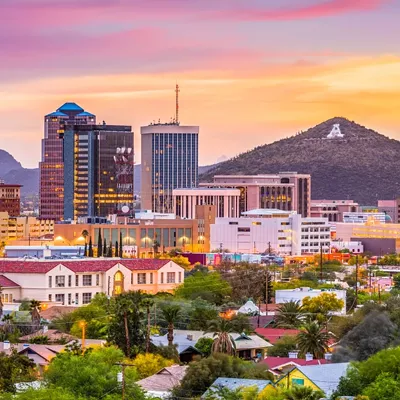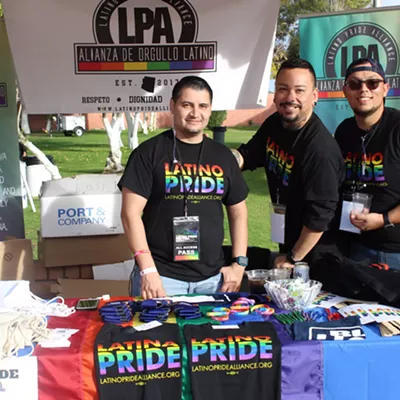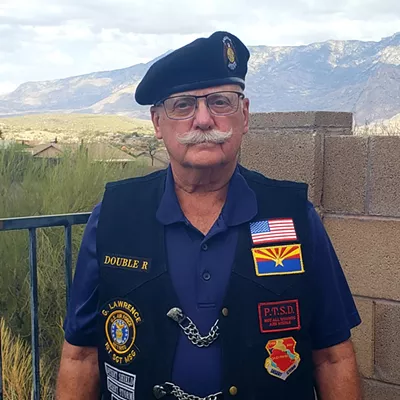West of downtown Tucson near St. Mary's Hospital, Tumamoc Hill stands as Tucson's version of the Acropolis, with its 300 B.C.-era Hohokam rock walls, terraces and home sites, and Tohono O'odham burial areas mingled among more than 20 research studies being conducted by the UA Desert Laboratory.
As Venable scrambles over the hill's rocks, formed by lava blasts about 70 million years ago, he notes the hill's marriage to scientific research, which began when the Carnegie Institute of New York built a research station there in the early 1900s.
If not for the laboratory's early days, the study of ecology that Venable and Rosenzweig champion today, including Venable's research of desert annuals on the hill's north and northwest slopes, wouldn't exist.
"I have more than $1 million in National Science Foundation-funded research on the Tumamoc Hill land," Venable says.
Venable, the lab's director of research, says it's this rich history that makes Pima County's latest attempt to purchase 320 acres of Tumamoc Hill from the state's land trust meaningful.
In October, Venable and Rosenzweig , the director of the laboratory, gave a presentation to the Pima County Board of Supervisors. The supervisors were considering an application submitted by county supervisor Richard Elias to purchase the land from the Arizona State Land Department. The board unanimously approved the application.
The county, along with the UA Desert Laboratory, has been here before. In 1997, voters approved $1.8 million in bonds to buy the site, but the county never had enough money to complete the purchase. Then there were two failed attempts at trust-land reform that could have made the purchase possible.
Under the current law, the Land Department must sell state trust land at public auction to the highest bidder to maximize profit, since the funds raised from auction are earmarked for public education. It's in the state's Constitution.
The 320 acres are part of three parcels on the hill that make up the lab's 850 acres, Rosenzweig says.
"The laboratory isn't a building or a group of buildings, but the land itself. That is our laboratory," Rosenzweig says. "As Tucson grows around us, it's important people understand why this land is very special. For us, it's our laboratory. For five tribes in the area, the land is sacred."
There are more than 20 studies being done at the lab, half of which are taking place on the 320 acres that Pima county and the UA want to secure as open space. The property is located east of Greasewood Road and north of Star Pass Boulevard, near areas of significant development.
The hill is also a recreation spot, with hundreds of walkers going from its base to the top daily. It's one of the last open-space areas adjacent to Tucson's urban core.
Rosenzweig says two long-term studies going back to Carnegie Institute days are taking place on the 320 acres. There also happen to be two petroleum pipelines that go through the property, as well as a long-closed UA landfill known to be contaminating nearby groundwater. The county estimates cleanup will cost $9 million to complete--and if the land were to be sold to a developer rather than being protected as open space, the county may also have to pay mitigation costs to that developer.
This, coupled with the downturn in real estate values, could help the county finally make its purchase. The county is better prepared this go-around, with almost $12 million available to purchase the land. More than $2 million has been transferred from other bond projects, and Pima County eligibility for the state's Growing Smarter program could provide matching funds to bring the $12 million together.
Another boost could come thanks to federal legislation from Reps. Raul Grijalva and Gabrielle Giffords, which could help reform state trust land or allow the county to condemn the property.
Rosenzweig and Venable say this is the closest they feel the property's been to actually being protected. However, there remains a possibility that developers could step forward and offer a higher bid.
Meanwhile, Venable and Rosenzweig say these are exciting times for the laboratory. Rosenzweig, a professor of environmental and evolutionary biology at the UA, is leading the development of the Alliance for Reconciliation Ecology. While the greater Tucson community may look at Tumamoc Hill as a destination for early morning walks, it's the Alliance for Reconciliation Ecology that might help the average Tucsonan reconnect to the city's true desert landscape.
"We are extending the knowledge of the lab to the greater Tucson community," says Rosenzweig.
The alliance uses principles developed by Rosenzweig and other scientists in research on species diversity. Rosenzweig detailed his research in his book Win-Win Ecology to show how ecology can help developed areas boost plant and animal populations with an increase in certain shrubs, trees or habitats. As Tucson grows, Rosenzweig says, the community needs to find ways to work with nature rather than continuing to take it over.
"We have to figure out how to reconcile human needs and reduce our use of land," says Rosenzweig. "Nobody has taken that on."
Until now. The alliance is in its development stages, but in about six months, neighborhoods could turn to the Desert Laboratory for special nature recipes. If you want more quail or hummingbirds, both species native to the area, the Alliance for Reconciliation Ecology could tell you what to plant to bring more of those birds to your property.
"We can tell you how to get them," he says. "This growing city is challenging nature's right to exist. Can we maintain (nature) in our own urban setting? This is a way we can and a way to empower the people in their neighborhoods."
Venable says the existence of the Desert Laboratory is crucial as the planet continues to heat up.
"The long-term research helps monitor the ecological changes taking place," Venable says. "This makes the lab and the land valuable for everyone, not just Pima County."

